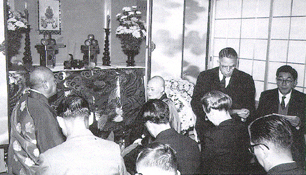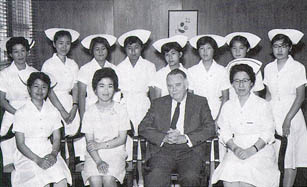Better US-Japan Understanding Cultivated
by Kenji Joji
ABCC-RERF Translation Section Chief, 1953-89

The author, far right, interpreting for George B Darling in 1963 at a Buddhist ceremony held for families of the deceased who had been autopsied as part of the ABCC-RERF pathology program, which was conducted from 1955-88.
No one has left as indelible an imprint on the long history of ABCC as George B Darling. As ABCC’s director, he demonstrated uncommon leadership, skill, and diplomacy in conducting a unique binational scientific investigation, and contributed to the welfare of humanity and to closer friendship and understanding between the United States and Japan.
Reappraisal of ABCC mission
In the early 1950s, serious questions were raised concerning the feasibility of continuing ABCC’s research program, despite a consensus in the scientific community that decades of study would be required to answer the unresolved questions regarding the late effects of radiation on human beings.
Addressing this need, R Keith Cannan, chairman of the Division of Medical Sciences, National Research Council, convened in October 1955 a meeting of NAS-NRC consultants to review the research design of ABCC. This meeting led to the recommendation that a Unified Study Program based on a fixed population be created. An Ad Hoc Committee for Reappraisal of the ABCC Program was thus created, headed by Thomas Francis Jr, professor of epidemiology, University of Michigan. The Francis Committee’s recommendations became the blueprint of the future research program at ABCC-RERF.
Cannan was well aware of the political climate in Japan following the signing of the US-Japan Peace Treaty, of the possible repercussions of the enactment of the Atomic Bomb Survivors Medical Treatment Law, and of the need for both scientific and diplomatic leadership and wisdom in implementing the Francis Committee’s recommendations. In 1957, Darling was appointed director of ABCC.
Linked by language
Realizing that ABCC’s research program could not be smoothly and effectively conducted without the cooperation of the local communities, the scientific community, and the government agencies concerned, in July 1957 Darling directed that all technical reports be published in a bilingual format and that all forms used in research also be bilingual.
In the same vein, in the next year he successfully arranged with the Hiroshima Prefectural Medical Association to establish an ABCC Section in the Journal of the Hiroshima Medical Association so ABCC’s research achievements could be published in the open literature in Japan.

Darling is remembered by a colleague as being a staunch advocate of the ABCC nursing staff. Seated to Darling’s left is Chiyoko Watanabe, chief of ABCC nursing from 1953-78
Linked by language
Later in 1958, Cannan arranged to provide the needed continuity in program supervision for ABCC: the ABCC Department of Medicine through association with Paul Beeson, Department of Medicine, Yale University; the ABCC Department of Statistics through Gilbert Beebe, Follow Up Agency, NAS-NRC; and the ABCC Department of Pathology through Sidney Madden, Department of Pathology, University of California at Los Angeles.
Thanks to the spirit of binational cooperation and collaboration painstakingly created by Dr Darling and his staff, the Unified Study Program became and continued to be scientifically productive, and thus gained internationally greater recognition and a strong endorsement from the Japanese Advisory Council to ABCC, the NAS-NRC Advisory Committee on ABCC, and the US Atomic Energy Commission that it be continued on a long-term basis despite the aggravating financial situation in the United States, which at the time provided most of the operational funds.
When Darling retired after more than 15 years of meritorious service as director of ABCC, he returned to the US having laid the cornerstone of the new, truly binational organization he had envisioned.
This article was originally published in RERF Update 3(3):8, 1991.

